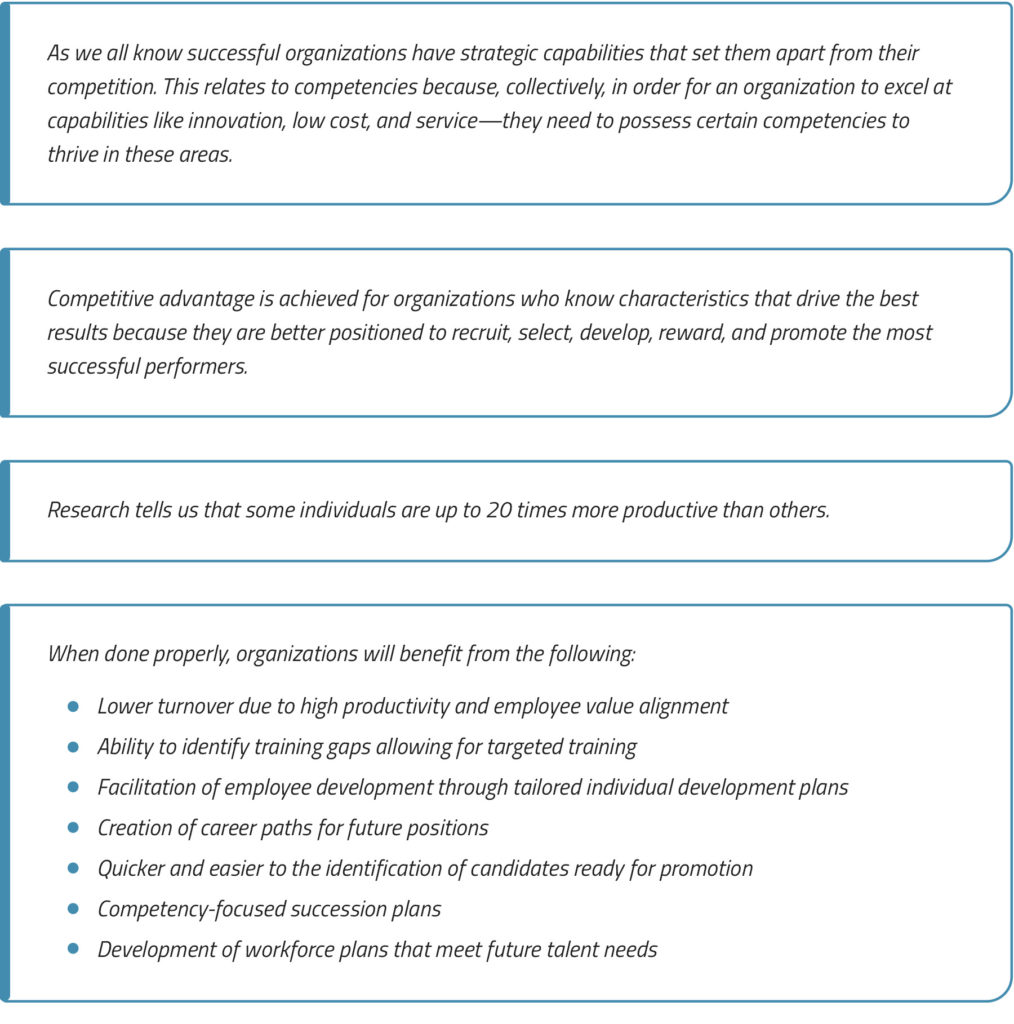
Workplace Learning has undergone a metamorphosis over the last decade and continues to evolve and reposition strategically. One of the significant changes is that L&D at the workplace has moved from a position of “nice to have” to a “need to have.” The criticality of workplace learning is growing and is today heavily focused on delivering the right skills and competencies to help employees perform better, leading to the achievement of business goals and objectives.
There are simply no two ways about it. Skills and competency-based training must be of utmost priority to enterprises. Various research reports too have stamped authority on this pressing need of skilling activities. Notably, McKinsey reports that 87 percent of executives have existing or imminent skill gaps. Allow us to highlight key findings from one such remarkable paper, Competency-Based Training Basics (New York: ASTD, 2010), William J. Rothwell and Jim M. Graber.

Table of Contents
The Delivery of Workplace Learning
While the relevance and importance of competency-based training in workplace learning is increasing, it is, however, disappointing to take stock of the number of enterprises that are yet to revamp or evolve from their traditional training methods. With the level of digitization and dependencies on technology today, L&D in some organizations is lagging. There are a number of barriers to delivering effective training, and fortunately today training practices and tools have steadily evolved to tackle these very challenges. Such modern tools and technologies are all related to the digital world and the sophistication that eLearning brings to workplace learning. Furthermore, with the level of automation, artificial intelligence, and continued obsolescence of skills, digital learning experiences are critical to business growth, prosperity, and success.
Josh Bersin wrote in his post about what we have learned from digital disruption: “we don’t learn well through ‘binge education’ like a course. We learn by being exposed to new skills and ideas over time, with spacing and questioning in between.”
Organizations that have embraced a cautious blended training approach too are able to witness the impact of eLearning. The need of the hour is for businesses to take a step forward with L&D delivery, as we aim for better training for employees and enhance learning outcomes. This video below illustrates the success that awaits by taking a baby step; moving from an Instructor-led Training strategy to a Virtual Instructor-led Training strategy to deliver workplace learning.
This blog post proceeds to address precisely how eLearning and learning technology is the right approach for workplace learning. We will go on to bust the myth that competencies and skills training can be delivered only through a traditional training approach and strategy. We conclude by establishing that eLearning is best suited for the current global business climate and is the ideal choice to meet the needs of modern employees, along with acing enterprise goals.
What Makes eLearning Tick?
Digital learning experiences had truly found its footing even before the onset of the pandemic. L&D experts realized training need not be in the form of classroom sessions only and that learning could be “delivered” to employees at the workplace and beyond. L&D capitalized on digital advancements and modern tools to ensure learning experiences in the flow of work. Did you know that the use of digital learning tools has more than doubled in the last 10 years? As per the Learner Intelligence Report, 2020 saw digital jump further with spikes in e-learning courses, live online learning such as webinars, and the use of online performance support tools.
This leads us to the question. What makes eLearning tick? What are the benefits that await?
Here is a gist. Reports indicate that eLearning:
- Assisted over 40% of American enterprises to increase incomes
- Improves learner retention to upto 60%, as against 8% for in-person training
- Enhances productivity by 25% and engagement by 18%
This infographic below summarizes the power of eLearning.

eLearning and Competency-based Training
The article thus far captured the criticality of delivering skills and competencies to the workforce and looking at eLearning as a digital strategy for workplace learning. How can both not only come together but also leverage success? We are making a case for unparalleled success – eLearning to deliver competency-based training objectives and skills to employees. Let us begin by debunking a common misconception that competencies and skills training can be achieved only through formal/traditional means, i.e., classroom training – characterized by lectures, one-dimensional training, handouts, study material, etc.
Classroom training is away from the equipment, processes, and materials that employees use on the job. The lack of understanding, relevance, and application of new knowledge cannot be emphasized enough. Did you know that learners forget upto 70% within 24 hours and upto 90% of what they have learned within a week? With this glaring truth, what kind of learning outcomes can be achieved through a simple classroom training session with a hosepipe approach to impart new skills and long-term competencies? Assessment of knowledge assimilation and how it helps in the application while on the job also remains undeterminable to a large extent.
Further, deploying eLearning for competency-based learning has a host of merits. We highlight just some of the key aspects that serve as a case to debunk the age-old myth:
- Deliver skills at the speed of business: Automation has indeed shaped our jobs, roles, and responsibilities. With dynamic market conditions and global interdependence of products, resources and services, businesses are constantly on the move. There is never a dull moment, and organizational goals and objectives symbolize this growth, trajectory, and success. In such a fast-paced environment, can employees pause to attend a training session? Further, with the constantly evolving needs, are employees suitably trained to perform at their best? Skill gaps are a harsh reality we face today and this needs to be plugged at the earliest while also establishing skills needed for the future. The only effective way to deliver this is through digital learning experiences or eLearning, in the flow of work.
- Anytime-anywhere learning: eLearning ensures that workplace learning is not restricted only to the place of work. Employees may need training and guidance at any place and at any time, to remain indispensable to a customer. eLearning assets are always accessible and provide value to the learner. Further, eLearning motivates learners to seek informal learning too. A video nugget of the product’s latest features or a gamified quiz or assessment or a scenario-based module on handling crises can capture the essence of learning while delivering enjoyable learning experiences beyond the workplace and hours of work.
- Implement advanced learning strategies: With new skills and emerging skills for the future, the entire skilling mission should be coordinated with the needs and demands. Teaching these new skills and competencies through traditional classroom training / Instructor-led sessions will defeat the purpose. Employees will be at ease and aim towards better application only when the training is hands-on and constant. Skills are not learned inside a classroom and are effectively understood only through time-tested and advanced learning strategies and technologies. From detailed webinars, microlearning modules for spaced learning, virtual reality modules for a 360-degree view, expert-speak podcasts, gamified experiences for troubleshooting, and more ensure superior learning outcomes. When these modern technologies are combined with the 70-20-10 model of learning or the ADDIE model, success in delivering competencies most effectively is the only outcome.
- Foster self-paced learning: Organizational L&D is headed the self-paced way, and this would be the goal for all learning organizations. Curating curriculums for skill enhancement, competency goals, and advancements in career are what modern employees seek from employers. eLearning is the perfect ally to tick all these boxes. Modern learning management systems and Learning Experience Platforms encourage learners to be in charge and are curating learning experiences for their audience. Additionally, in the current business climate, eLearning helps to conquer needs swiftly and efficiently.
- Improve performances and productivity: There is no doubt that eLearning creates learning moments in the flow of work. From performance support solutions to just-in-time training, such learning aspects delivered at the right time contributes directly to workforce performances. It motivates and enables employees to work better, smarter, effectively, and productively. Organizations thus create a competent and skilled workforce, ready to face the challenges of tomorrow.
- Establish a culture of continuous learning: Establishing a learning culture and achieving continuous learning has been one of the top priorities for L&D leaders. Through the advancement of technology like xAPI mapping, eLearning ensures ample learning opportunities. New learning in the flow of work, spaced retention, competent performance support solutions and informal learning are just some of the ways eLearning can ensure a state of continuous learning in the organization.
- Measure impact: eLearning is uniquely poised to measure reach, progress, and outcomes. With assessment tools, progress bars, engagement generated, and much more, eLearning provides valuable insights into learner behavior. Additionally, it gives the opportunity to review current courses and curricula and deliver enhanced learning that resonates with the audience. Learning analytics are a wealth of information that L&D leaders can rely on. Learning outcomes are also certain and predictable. Isn’t this the goal of any training or skilling program?
Workplace Learning In-action
To best illustrate how eLearning can propel businesses to growth, success and stability, here is a case study of a leading organization. How did it deliver new skills and competencies while also creating leaders of tomorrow? Read this detailed report including the requirement, challenges and outcomes achieved.
Read Case Study for Workplace Learning
This video is another example of how self-paced eLearning helped an enterprise to rapidly scale its learner ecosystem, improve knowledge application, and drastically improve course completion rate.
To know more about creating effective workplace learning solutions for your organization, write to info@originlearning.com
